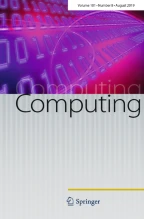Abstract
Privacy is one of the most important issues in social social network data sharing. Structure anonymization is a effective method to protect user from being reidentfied through graph modifications. The data utility of the distorted graph structure after the anonymization is a really severe problem. Reducing the utility loss is a new measurement while k-anonymity as a criterion to guarantee privacy protection. The existing anonymization algorithms that use vertex’s degree modification usually introduce a large amount of distortion to the original social network graph. In this paper, we present a \(k\)-degree anonymity with vertex and edge modification algorithm which includes two phase: first, finding the optimal target degree of each vertex; second, deciding the candidates to increase the vertex degree and adding the edges between vertices to satisfy the requirement. The community structure factors of the social network and the path length between vertices are used to evaluated the anonymization methods. Experimental results on real world datasets show that the average relative performance between anonymized data and original data is the best with our approach.






Similar content being viewed by others
Explore related subjects
Discover the latest articles, news and stories from top researchers in related subjects.References
Kisekka V, Bagchi-Sen S, Raghav Rao H (2013) Extent of private information disclosure on online social networks: an exploration of Facebook mobile phone users. Comput Hum Behav 29(6):2722–2729
Shibchurn J, Yan X (2015) Information disclosure on social networking sites: an intrinsic-extrinsic motivation perspective. Comput Hum Behav 44:103–117
Sweeney L (2002) k-Anonymity: a model for protecting privacy. Int J Uncertain Fuzziness Knowl-Based Syst 10(5):557–570
Machanavajjhala A et al (2007) L-diversity: privacy beyond k-anonymity. ACM Trans Knowl Discov Data 1(1):3
Li N, Li T, Venkatasubramanian S (2007) t-Closeness: privacy beyond k-anonymity and l-diversity. In: IEEE 23rd international conference on data engineering (ICDE’07), pp 106–115
Zhou B, Pei J (2008) Preserving privacy in social networks against neighborhood attacks. In: IEEE 24th international conference on data engineering (ICDE’08), pp 506–515
Narayanan A, Shmatikov V (2009) De-anonymizing social networks. In: Proceedings of the 30th IEEE symposium on security and privacy. IEEE Computer Society. pp 173–187
Borgatti SP, Mehra A, Brass DJ, Labianca G (2009) Network analysis in the social sciences. Science 323(5916):892–895
Backstrom L, Dwork C, Kleinberg J (2007) Wherefore art thou r3579x?: anonymized social networks, hidden patterns, and structural steganography. In: Proceedings of the 16th international conference on world wide web. ACM, Banff, pp 181–190
Campan A, Truta T (2009) Data and structural k-anonymity in social networks. In: Bonchi F (eds) Privacy, security, and trust in KDD. Springer, Berlin, pp 33–54
Cheng J, Fu AW, Liu J (2010) K-isomorphism: privacy preserving network publication against structural attacks. In: Proceedings of the 2010 ACM SIGMOD international conference on management of data. ACM, Indianapolis, pp 459–470
Chester S et al (2011) k-Anonymization of social networks by vertex addition. In: Proceedings II of the 15th east-european conference on advances in databases and information systems, CEUR-WS, Germany, pp 107–116
Hay M et al (2008) Resisting structural re-identification in anonymized social networks. Proc VLDB Endow 1(1):102–114
Liu K, Terzi E (2008) Towards identity anonymization on graphs. In: Proceedings of the 2008 ACM SIGMOD international conference on management of data. ACM, Vancouver, pp 93–106
Wu W et al (2010) k-Symmetry model for identity anonymization in social networks. In: Proceedings of the 13th international conference on extending database technology. ACM, Lausanne, pp 111–122
Zou L et al (2009) k-Automorphism: a general framework for privacy preserving network publication. Proc VLDB Endow 2(1):946–957
Hay M et al (2007) Anonymizing social networks. University of Massachusetts Amherst, Amherst
Lu X, Song Y, Bressan S (2012) Fast identity anonymization on graphs. In: Liddle S (eds) Database and expert systems applications. Springer, Berlin, pp 281–295
Blondel VD et al (2008) Fast unfolding of communities in large networks. J Stat Mech Theory Exp 2008(10):P10008
Newman ME, Girvan M (2004) Finding and evaluate community structure in networks. Phys Rev E 69(2):026113
Csrdi G, Nepusz T (2006) The igraph software package for complex network research. In: Proceeding of international conference on complex systems 2006 (ICCS2006). http://igraph.sf.net. Accessed April 2015
Chester S et al (2013) Why Waldo befriended the dummy? k-Anonymization of social networks with pseudo-nodes. Soc Netw Anal Min 3(3):381–399
Leskovec J, Kleinberg J, Faloutsos C (2007) Graph evolution: densification and shrinking diameters. Trans Knowl Discov Data 1(1):2
Leskovec J et al (2009) Community structure in large networks: natural cluster sizes and the absence of large well-defined clusters. Internet Math 6(1):29–123
Gu B, Sheng VS (2013) Feasibility and finite convergence analysis for accurate on-line-support vector learning. IEEE Trans Neural Netw Learn Syst 24(8):1304–1315
Ma T et al (2015) Detect structural-connected communities based on BSCHEF in C-DBLP. Concurr Comput Pract Exp. doi:10.1002/cpe.343
Acknowledgments
This work was supported in part by National Science Foundation of China (No. 61173143), Special Public Sector Research Program of China (Nos. GYHY201506080, GYHY201206030) China Postdoctoral Science Foundation (No. 2012M511303), and was also supported by PAPD. The authors extend their appreciation to the Deanship of Scientific Research at King Saud University for funding this work through Research Group No. RGP-264.
Author information
Authors and Affiliations
Corresponding author
Rights and permissions
About this article
Cite this article
Ma, T., Zhang, Y., Cao, J. et al. \(\varvec{\textit{KDVEM}}\): a \(k\)-degree anonymity with vertex and edge modification algorithm. Computing 97, 1165–1184 (2015). https://doi.org/10.1007/s00607-015-0453-x
Received:
Accepted:
Published:
Issue Date:
DOI: https://doi.org/10.1007/s00607-015-0453-x



